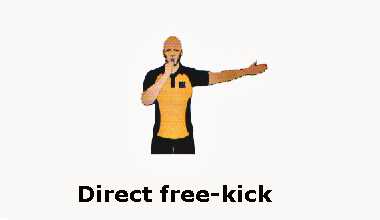Football Referee Hand Signals
Identify & understand the different hand signals that football referees make during a game

Every time referee stops the play, he blows his whistle and makes hand gestures. These gestures communicate the reason for stopping play and are the same for every league or competition worldwide. This allows the referee and players, who may not speak the same language, to understand each other.
Understanding soccer referee hand signals helps you know what really is happening on the pitch when playing is stopped. Below are the hand signals that head soccer refs make when officiating a game.
 Goal kick
Goal kick
To make a goal kick signal, the ref points at the goal with his arm straight, and palm open.
A goal kick in football is awarded to a team if an offensive player plays the ball out of bounds over the goal line.
 Corner kick
Corner kick
A ref signals for a corner kick by pointing to the corner flag where the kick must be taken.
A corner kick in football is awarded when a defensive player plays the ball out of bounds over the goal line.
 Penalty kick
Penalty kick
To signal for a penalty kick, the ref points to the penalty spot with his index finger. The penalty spot is the part of the football field where penalty kicks are taken, indicated by a bold dot.
The penalty kick is awarded to an offensive player when he is fouled inside the penalty area.
 Direct free kick
Direct free kick
To make a signal for a direct free kick, a referee raises an arm diagonally upwards before pointing with his other hand to the direction of the offending player’s goal.
A direct free kick is a signal for serious offenses—a goal can be scored directly from it.
 Indirect free kick
Indirect free kick
To signal for an indirect free kick, the referee blows his whistle, raises an arm upwards and points to the direction of the kick. He keeps his arm raised until the ball has been kicked and touched by another player.
An indirect free kick is awarded for less serious offenses by an outfield player or for violation of goalkeeping rules.
Red card
When awarding a red card, the referee goes to the player who committed an offense then holds a red-colored card high up. After making this gesture, the referee gives the signal for a direct free kick, or a penalty kick if the offense happened inside the penalty area.
The referee gives a red card in a football game to send off a player who committed a very serious foul and misconduct.
Yellow card
 A yellow card is issued the same way with a red card. The yellow card in football is a caution for a serious rule violation. If a player is issued a yellow card for the second time in the match, he will be sent off from play.
A yellow card is issued the same way with a red card. The yellow card in football is a caution for a serious rule violation. If a player is issued a yellow card for the second time in the match, he will be sent off from play.
After awarding a second yellow card, the referee shows a red card to indicate that the offending player must leave the football field.
 Advantage
Advantage
The referee signals for an advantage by extending both arms in front of his body, palms facing up. If the advantage foul warrants a card, the referee will issue it to the offending player in the next dead ball.
The advantage signal is made when the referee sees a violation but allows play to continue. This happens in cases where letting play go on would be more advantageous to the fouled team than stopping it. To know more, read our article about Advantage rule explained.
